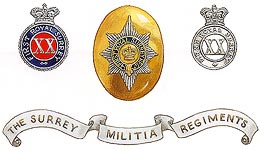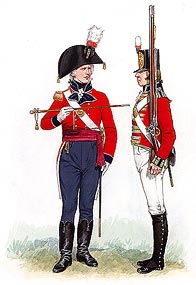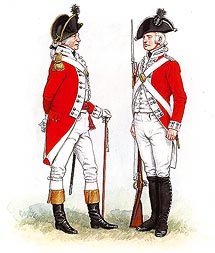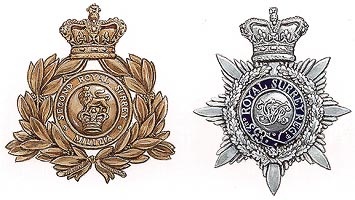Militia And Volunteers
The Background

 |
| Officer and Private 2nd Royal Surrey Militia, 1805 |
The Militia was the oldest constitutional English military force, originating in the reign of King Alfred in 871. The Lords-Lieutenant of the counties had the charge of raising Militia in their respective areas on a quota basis proportional to the population since the 16th century. Charles I had tried to recruit Militia regiments for his royalist cause in 1642, but this was banned by Parliament, which declared that any men who attended would be punished as “disturbers of the peace”. After the Civil War, the Militia lapsed, but was revived and remodelled in 166. It was called out during the troubles between James II and William III. In 1756 there was a fear of French invasion and an act was passed, which called for the full embodiment of the Militia; this was to be raised by ballot and involved men aged between eighteen and fifty. They had to serve for three years and train four times a year. There was a strange distinction between regiments and battalions; Lords-Lieutenant raised “regiments” though if there were less than seven companies available, then “battalions” were raised.
Captains provided for the custody of arms, clothing and accoutrements, whilst churchwardens were required to find chests for the arms. Between 1756 and the end of the 18th century, the Militia was repeatedly embodied and disembodied, as external threats to the country changed; one key period of these changes was during the Napoleonic Wars of 1793-1816. A Local Militia was raised in 1808 and in 1811 the strength of the Regular Militia was 77,424 compared with the Local Militia of 213,609. In 1786, their three years service had been increased to five.
 |
| Officer Surrey Militia 1795. Private 2nd Surrey Militia (1st Supplementary Battalion), 1797. |
The Militia’s profile was greatly reduced after the Napoleonic Wars; little training took place and units were often only represented by a cadre of officers and a small group of soldiers. During the Crimean War of the 1850s, at least ten battalions of Militia, all volunteers, relieved regular battalions on garrison duties overseas. The Militia was then further revived during the Indian Mutiny of 1857 and then during 1899 and 1903 for the South African Wars. In 1871, the overall command of the Militia had been transferred from the Lords Lieutenant to the Crown; officers then gained their commissions directly from the Queen.
The Surrey Connection - Militia
The Surrey Militia was formed in 1759, as the latest war against
the French developed; initially, 800 men were appointed to be
raised in Surrey under their first Colonel, Richard Lord
Onslow, the Lord Lieutenant. Up to 1798, Surrey had one
militia Regiment known as “The Royal Surrey”, “The Surrey Regiment of Militia” or the “Old Surrey Militia”. Eventually,
the Surrey contingent was expanded to the 1st Royal Surrey
Regiment at Richmond, the 2nd (or 1st Supplementary
Battalion) at Guildford and the 3rd (or 2nd Supplementary
Battalion) at Kingston. The 3rd, however, was soon reduced
to a nominal title.

Related
